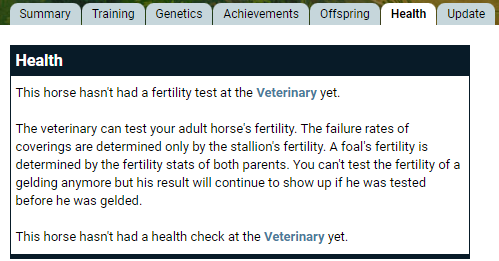Health stats consist of 5 traits that influence how prone to illness a horse is and 1 fertility stat. The stats will stay the same throughout a horse's life.
At the moment, diseases have not been implemented in the game. Therefore, your horses cannot get sick. However, the genes that determine if a horse is prone to an illness are already in the game and will in the future have an effect. It can therefore be beneficial to already take them into account in your breeding program.
Fertility is already in the game in the form of the semen quality of stallions and influences the chance of a failed pregnancy. A mare's fertility doesn't influence pregnancy success, but should not be neglected since fertility is a hereditary trait: A foal will inherit one fertility allele from its dam and one from its sire.
¶ Health Stats
You can find the health stats in the "Stats" tab of a horse's profile. They include fertility, colic resistance, hoof quality, back problems, respiratory disease, and resistance to lameness.

¶ Revealing the Health Stats
A horse's health stats are hidden upon birth. The five traits that relate to illness can be revealed by doing a health check at the veterinary. A fertility test will also reveal the fertility stat of an adult horse (at least 3 years old).
You can view the health stats of any horse as long as it has had one health check and is owned by a player or by Gisela. The stats of Foundation and Wildlife Park horses are hidden until they are bought and have their first health check.
This is what the Health section of a stallion looks like before he had his first health check:

This is the same Health section after the first health check and fertility test of the stallion:

¶ Numeric Value
Each stat has a hidden number behind it, which is the average of two numeric alleles. These numbers cannot get revealed, but depending on the number range that a stat falls in, it will get a specific label:
| Number | Label |
|---|---|
| 0 - 20 | Poor |
| 21 - 40 | Fair |
| 41 - 60 | Average |
| 61 - 80 | Good |
| 81 - 100 | Excellent |
The fertility stat uses the same labels, but note that they differ from the intervals used to determine the chance of a failed covering. These can be found on our breeding page.
¶ Changelog
- On August 5th 2025, the “fair” health stat was made to no longer be capitalised[1]